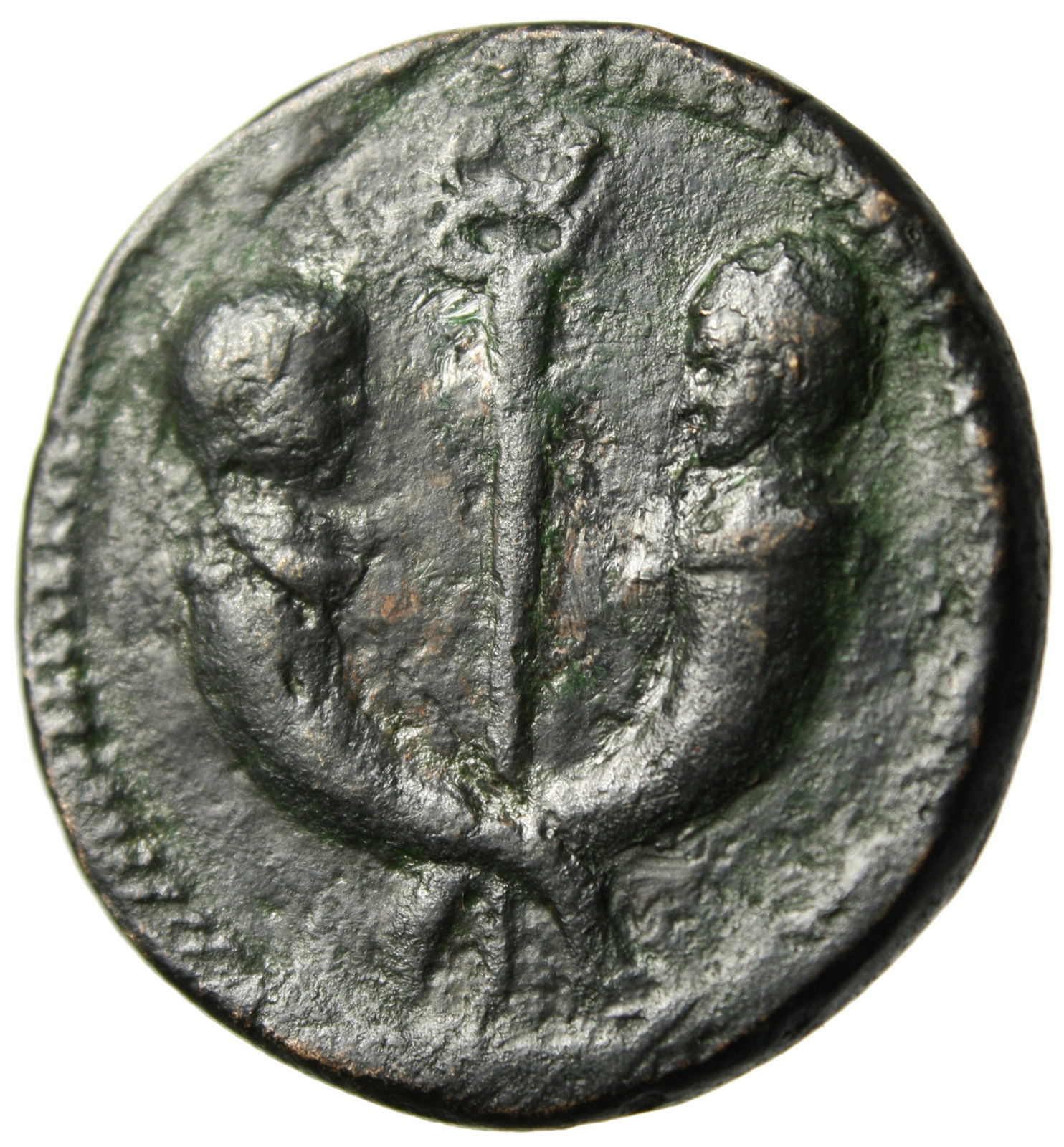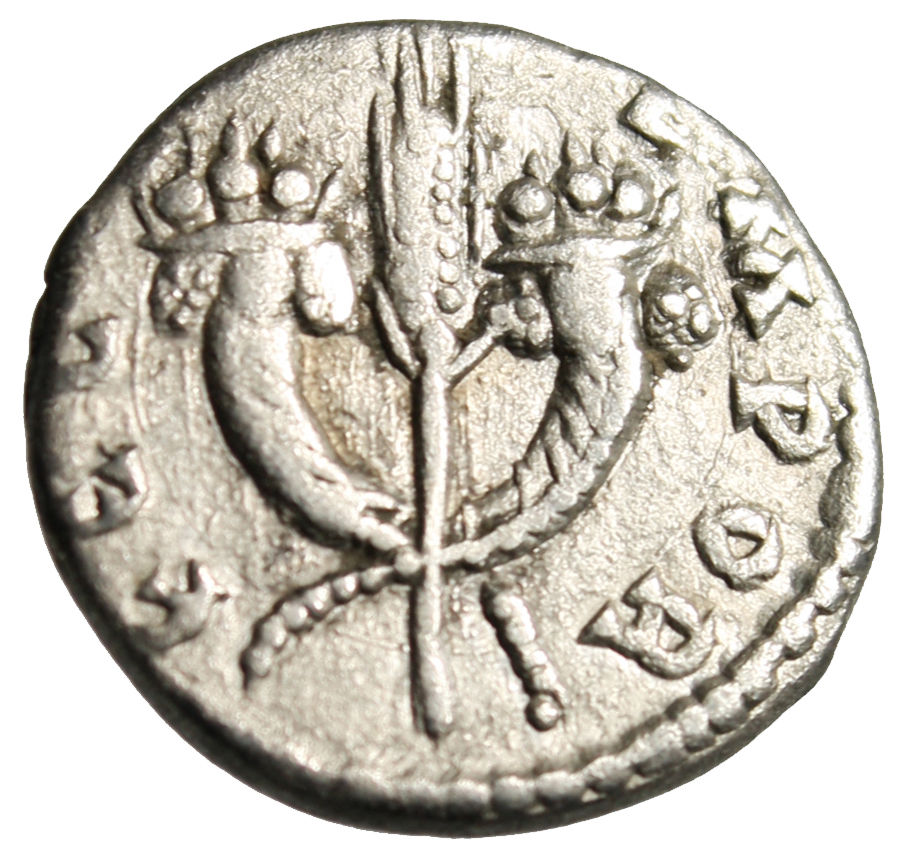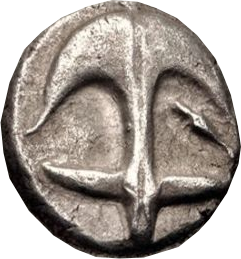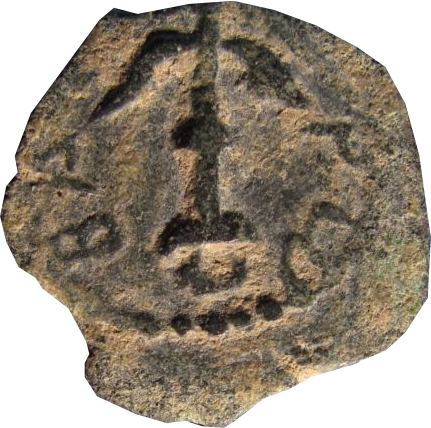Ancient Psychedelia: Alien Gods & Mushroom Goddesses
Online Book - Chapter 11, Page 221
Back to Online Book Mainpage / Next Page (Chapter 11, Page 222)
  R: (52j) Rome, Septimius Severus Grain ear between crossed cornucopia c. 194 AD Diodorus Siculus writes about the Dioskouroi: “[During the voyage of the Argonauts:] There came on a great storm and the chieftains had given up hope of being saved, when Orpheus, they say, who was the only one on ship-board who had ever been initiated in the Mysteries of the deities of Samothrake [the Kabeiroi (Cabeiri)], offered to these deities prayers for their salvation. And immediately the wind died down and two stars fell over the heads of the Dioskouroi (Dioscuri), and the whole company was amazed at the marvel which had taken place and concluded that they had been rescued from their perils by an act of providence of the gods. For this reason, the story of this reversal of fortune for the Argonauts has been handed down to succeeding generations, and sailors when caught in storms always direct their prayers to the deities of Samothrake and attribute the appearance of the two stars to the epiphany of the Dioskouroi.” (261) Finally, Pliny, in Natural History, writes of them: “And thereupon it is, that men assigne this mightie power to Castor and Pollux, and invocate them at sea, no lesse than gods. Men’s heads also in the even-tide are seene many times to shine round about, and to be of a light fire, which presageth some great matter. Of all these things there is no certain reason to be given, but secret these be, hidden with the majestie of Nature, and reserved within her Cabinet.” (262) There is the idea of being “born at the hip.” A mushroom is born at the hip of a fir tree, and Dionysus was rescued by Zeus and sewn into his thigh from where he was later born. Euripides writes: “In the compulsion of birth pains, the thunder of Zeus flying upon her, his [Dionysos’] mother [Semele] cast from her womb, leaving life by the stroke of a thunderbolt. Immediately Zeus Kronides received him in a chamber fit for birth, and having covered him in his thigh shut him up with golden clasps, hidden from Hera. And he brought forth, when the Moirai (Fates) had perfected him, the bull-horned god (theos taurokeros), and he crowned him with crowns of snakes (drakones), for which reason Mainades cloak their wild prey over their locks.” (263) |
Continuing: “Daughter of Akheloios, venerable Dirke [spring on Mt. Kithairon], happy virgin, you once received the child of Zeus [Dionysos] in your streams, when Zeus his father snatched him up from the immortal fire and saved him in his thigh, crying out: ‘Go, Dithyrambos, enter this my male womb. I will make you illustrious, Bakkhos, in Thebes, so that they will call you by this name’.” (264) Cain and Abel are very much like Castor and Pollux. In Genesis it is written: “(1) And the human knew Eve his woman and she conceived and bore Cain, and she said, ‘I have got me a man with the Lord.’ (2) And she bore as well his brother Abel, and Abel became a herder of sheep while Cain was a tiller of the soil. (3) And it happened in the course of time that Cain brought from the fruit of the soil an offering to the Lord. (4) And Abel too had brought from the choice firstlings of his flock, and the Lord regarded Abel and his offering (5) but did not regard Cain and his offering.” (265) Sometimes the mushroom deity is solo, and there is no pair or family. Sometimes they are represented in very strange, and even monstrous ways. While the Greeks were out there sailing their ships around the world, killing off the tribal cultures who used the mushroom for worship, they invented the anchor, from what the historians claim. Of course, they designed the anchor according to the shape of the mushroom as we can see on early Greek coins from 450-400 BC (48g), and as the anchor was carried into Judaism, it stayed on coins from the 40-4 BC era (51f).   R: (51f) Judea Herod I Anchor. c. 40-4 BC (261) Diodorus Siculus, Library of History 4. 43. 1 (trans. Oldfather) (Greek historian C1st BC (262) Sacred Mushroom, Allegro, p. 99; Pliny Natural History II, Chapter XXXVII (263) ibid; Euripides, Bacchae 90 ff (264) ibid, p. 107; Euripides, Bacchae 520 ff (265) Genesis 4:1-5 |
Go Back to Page 220